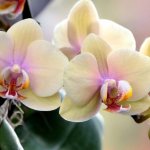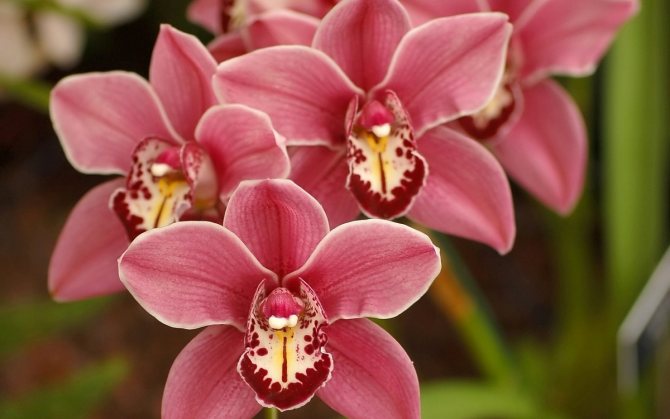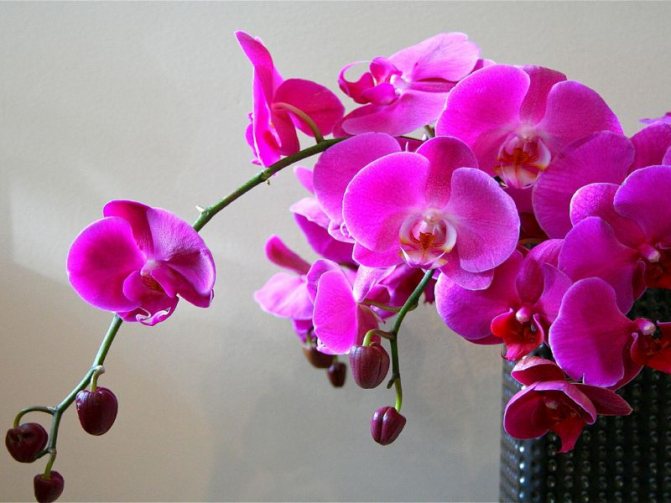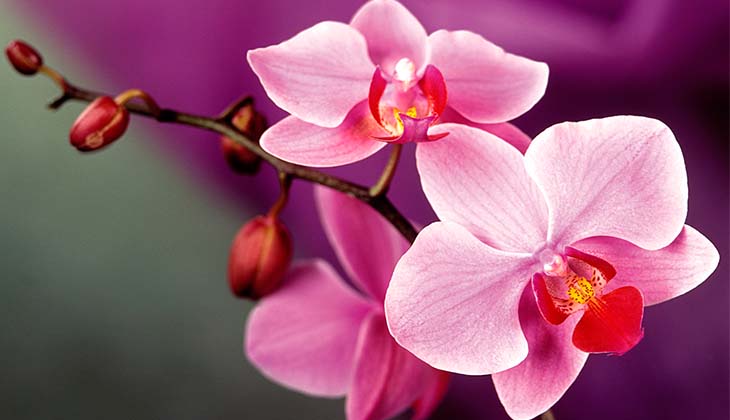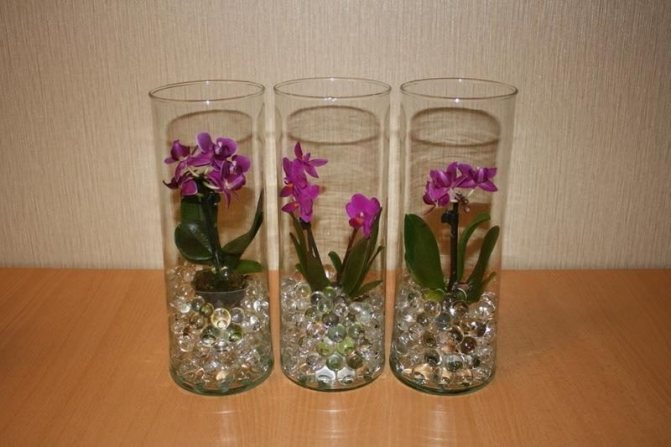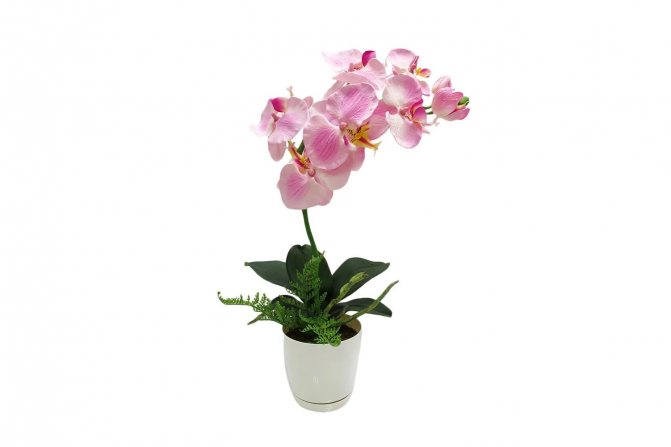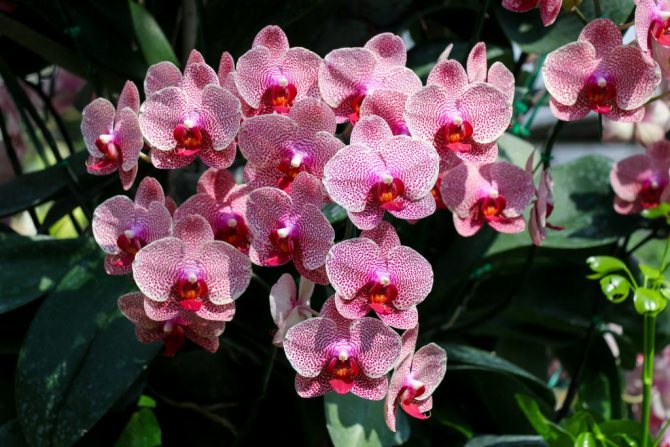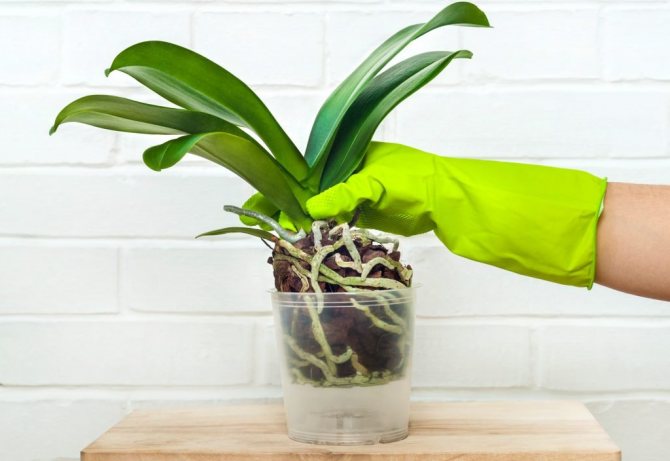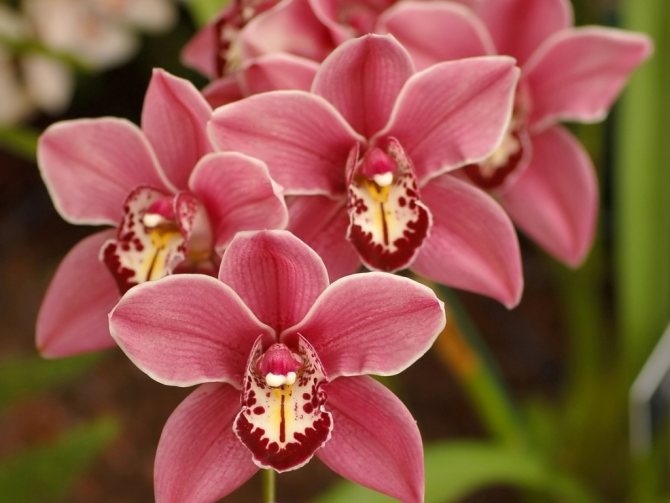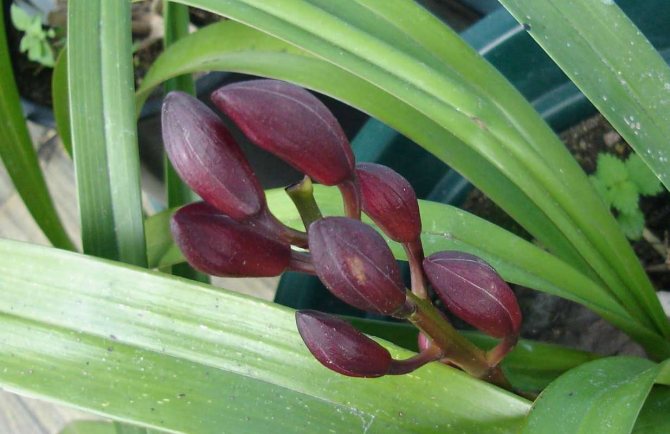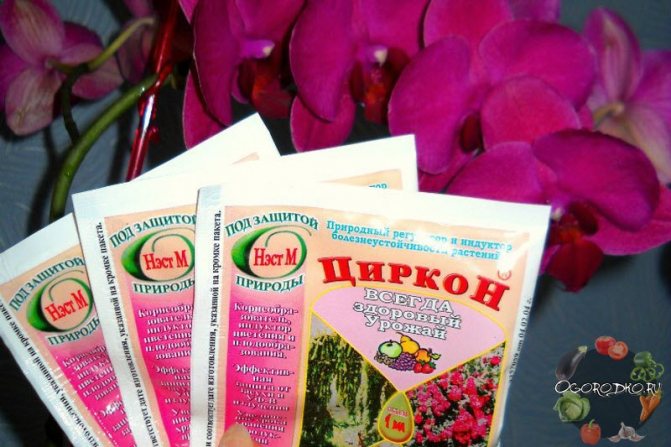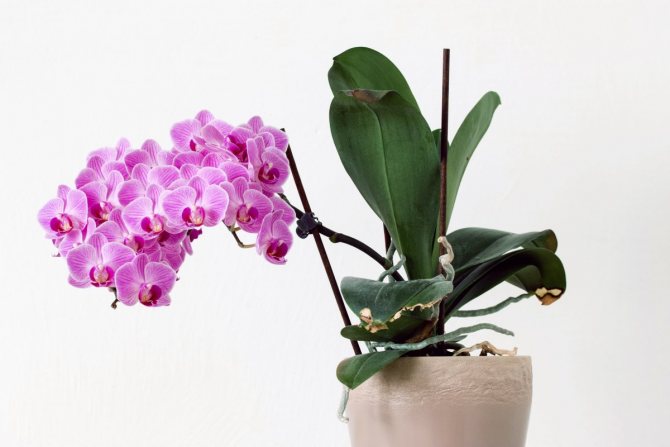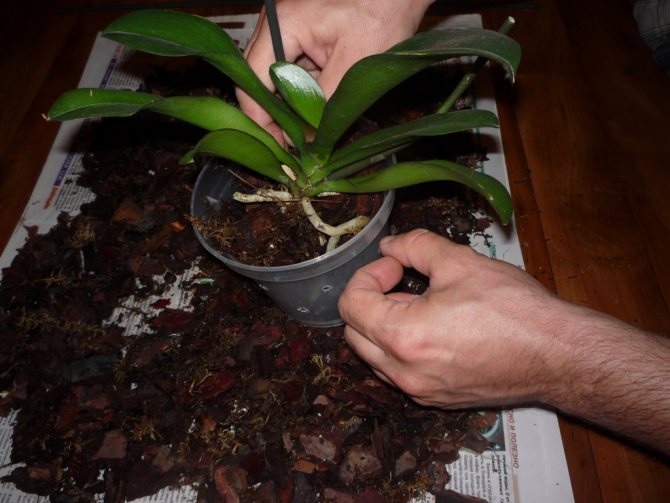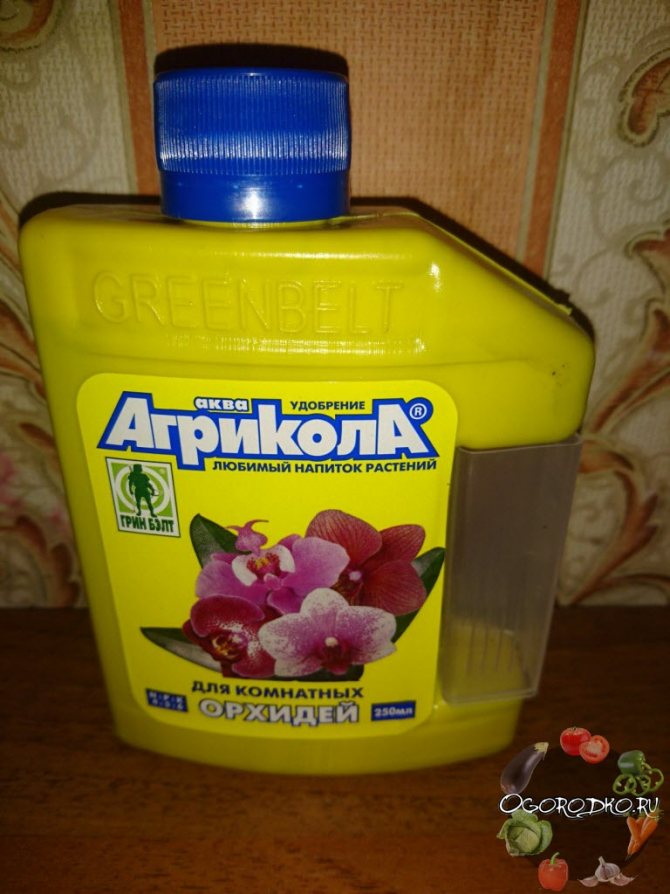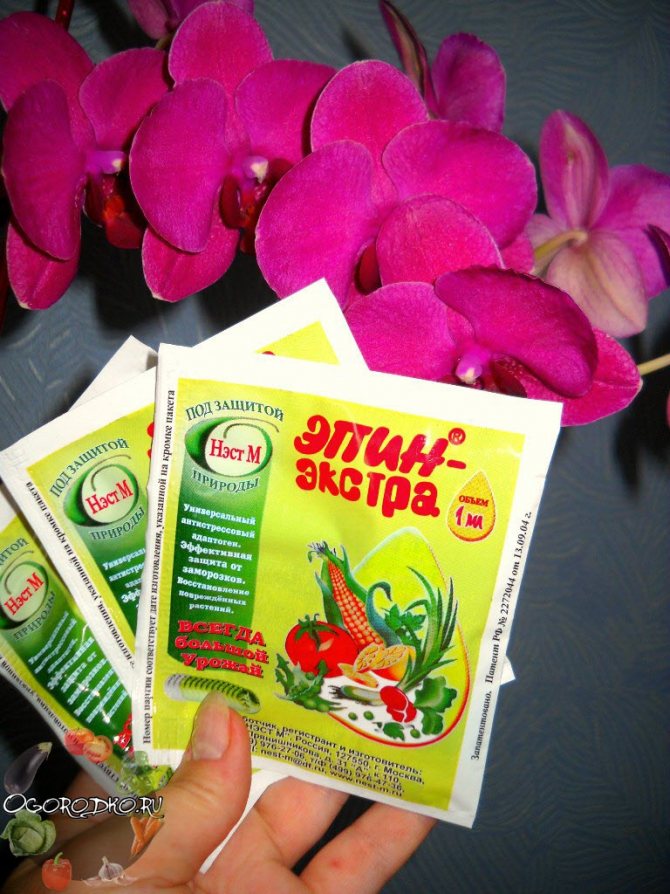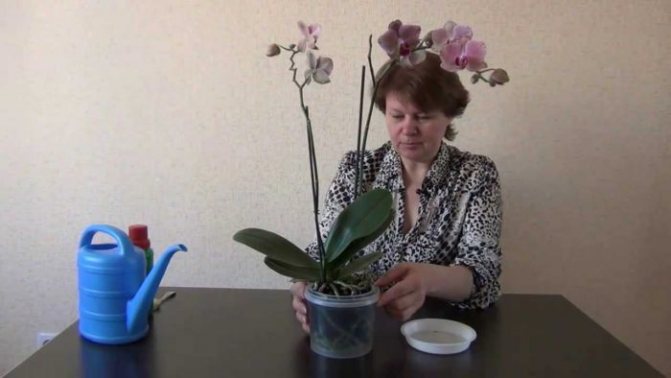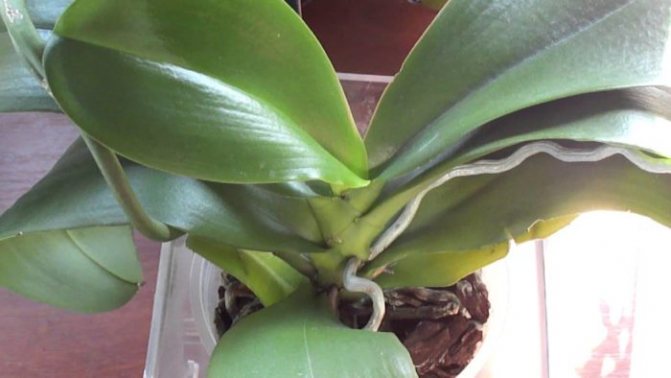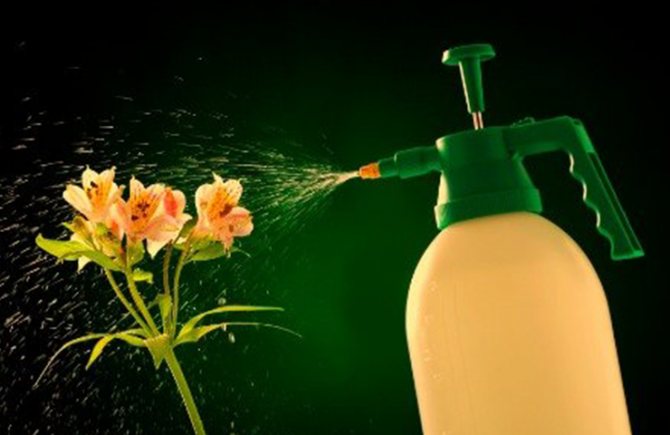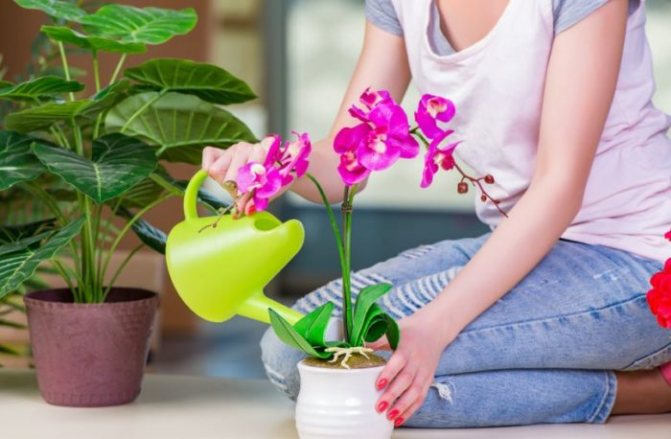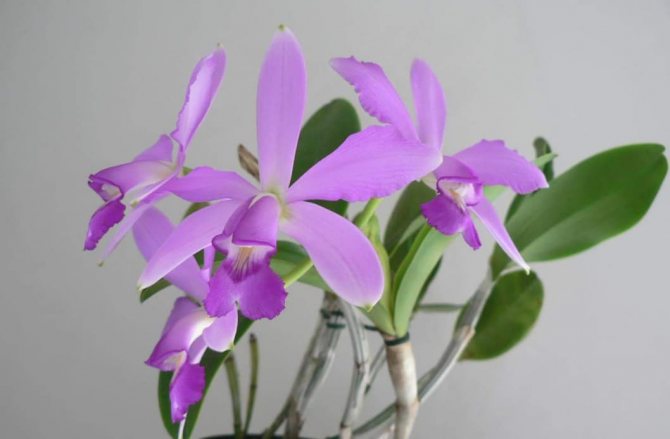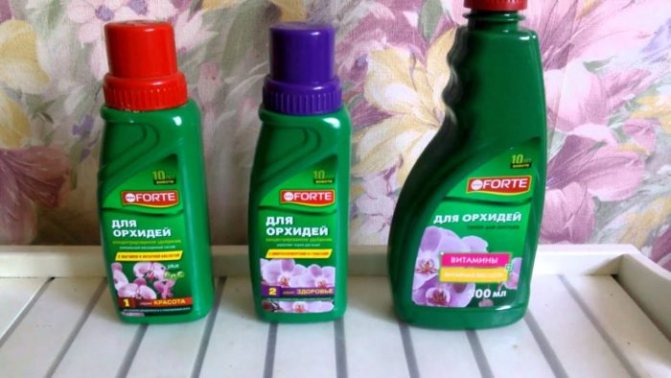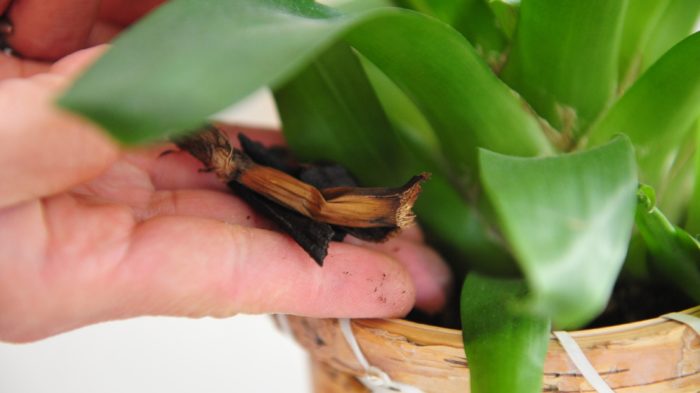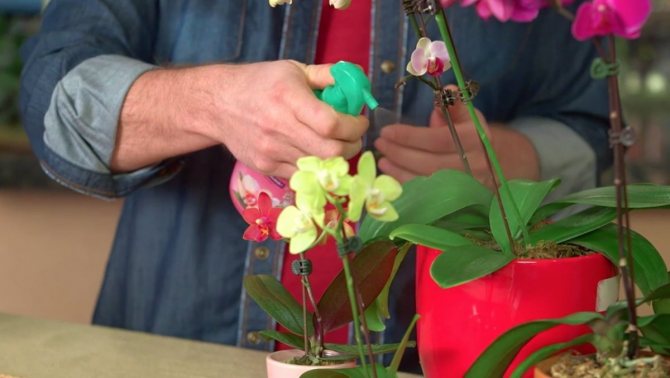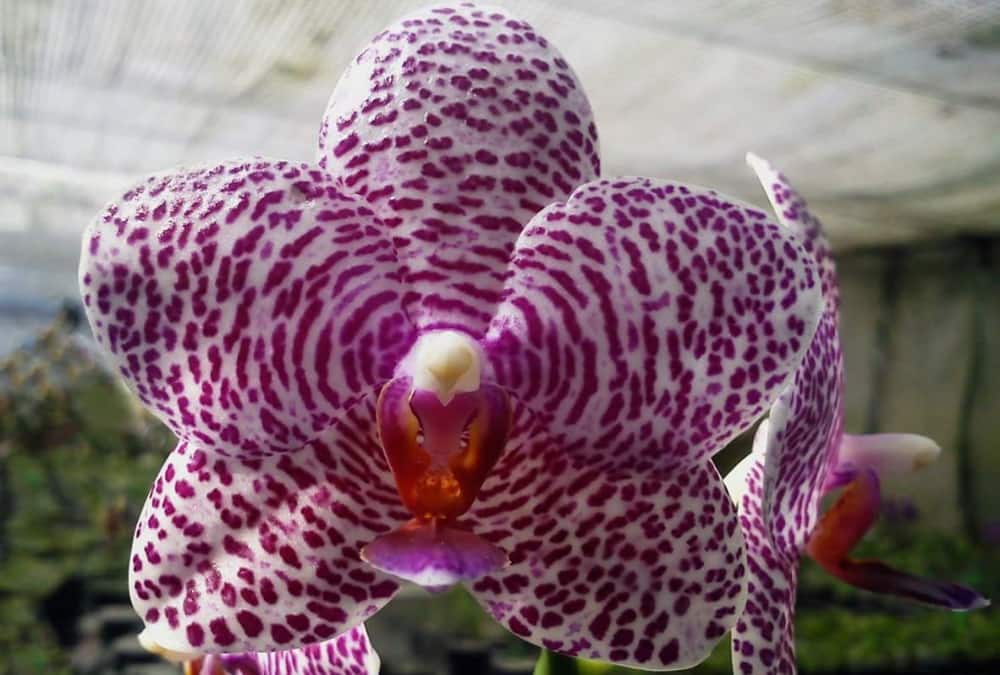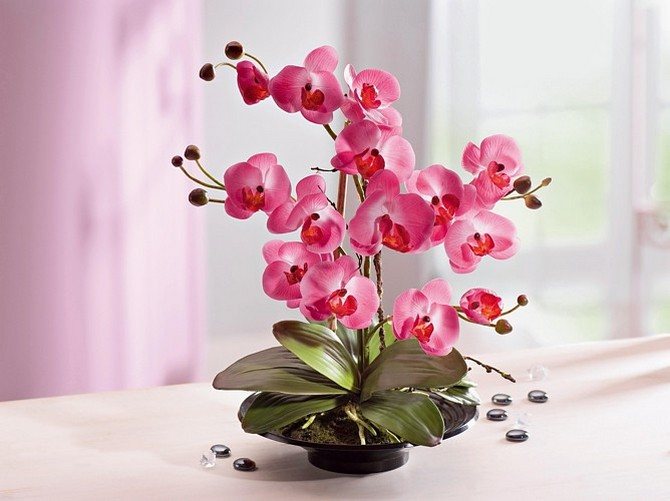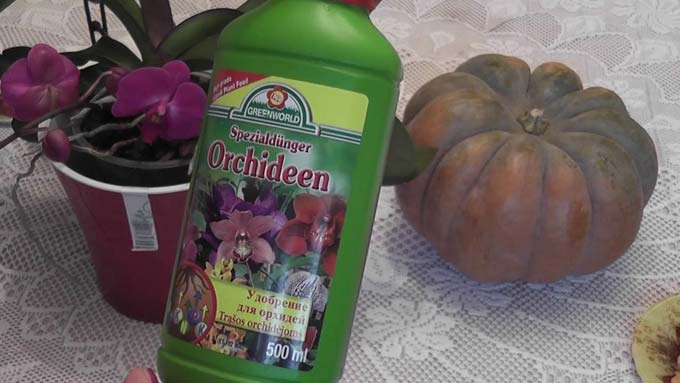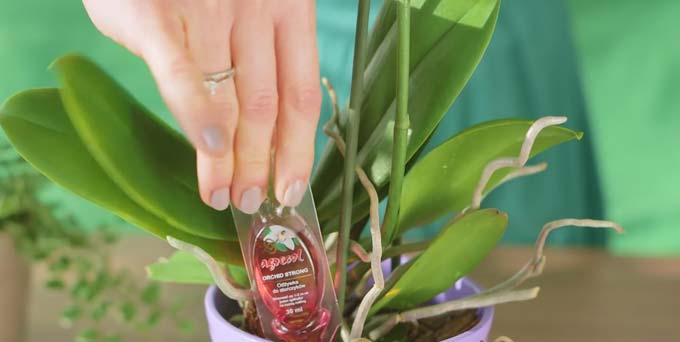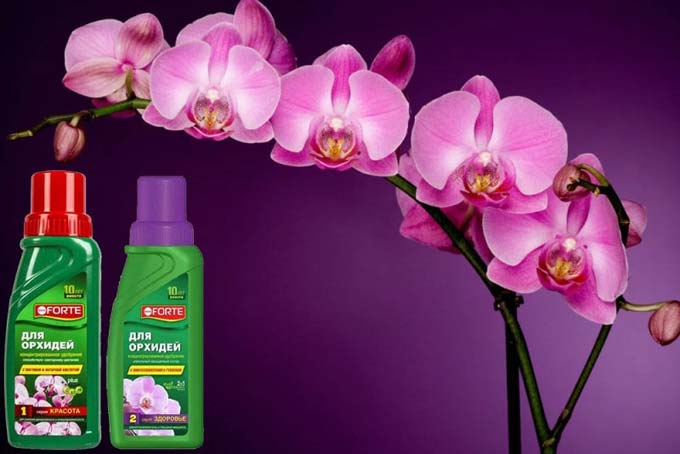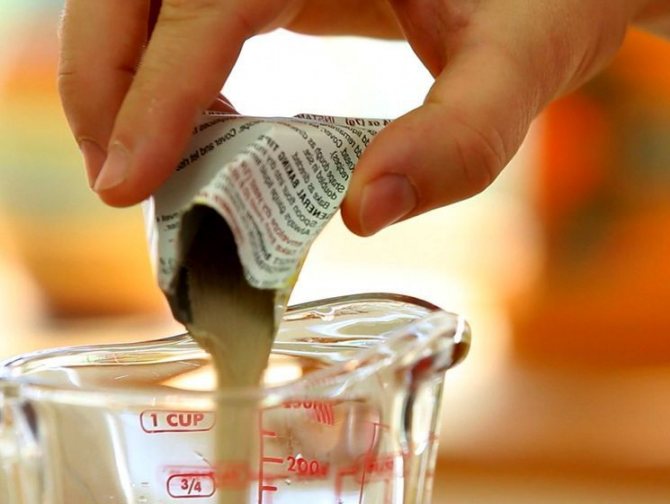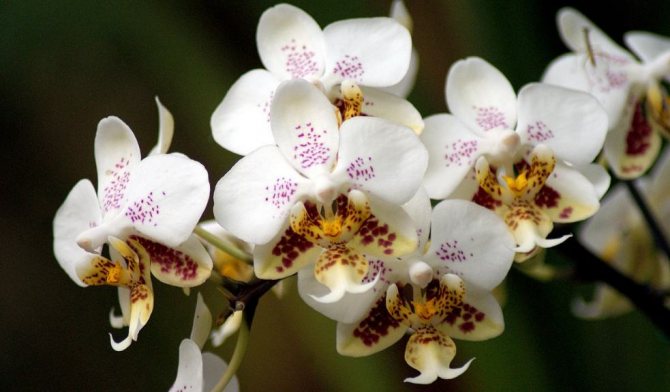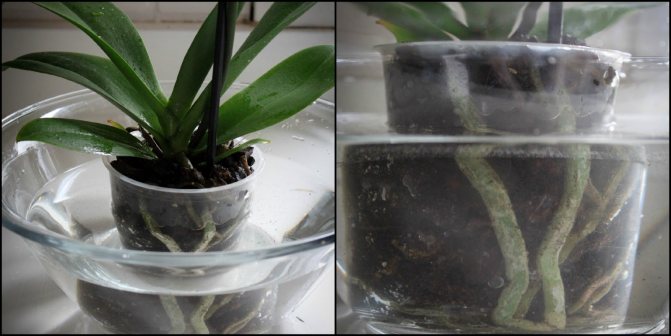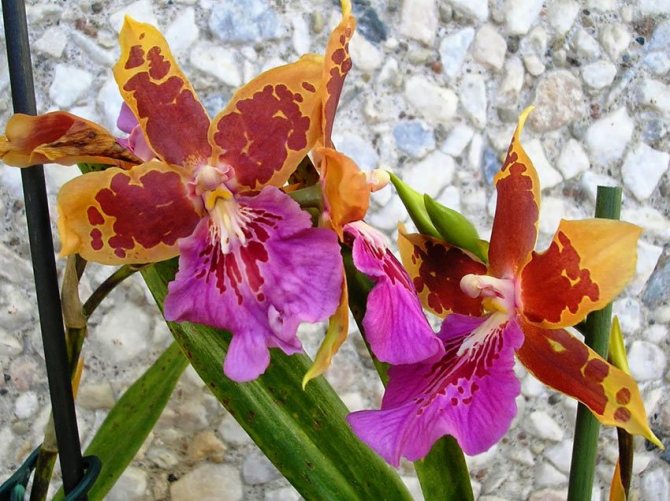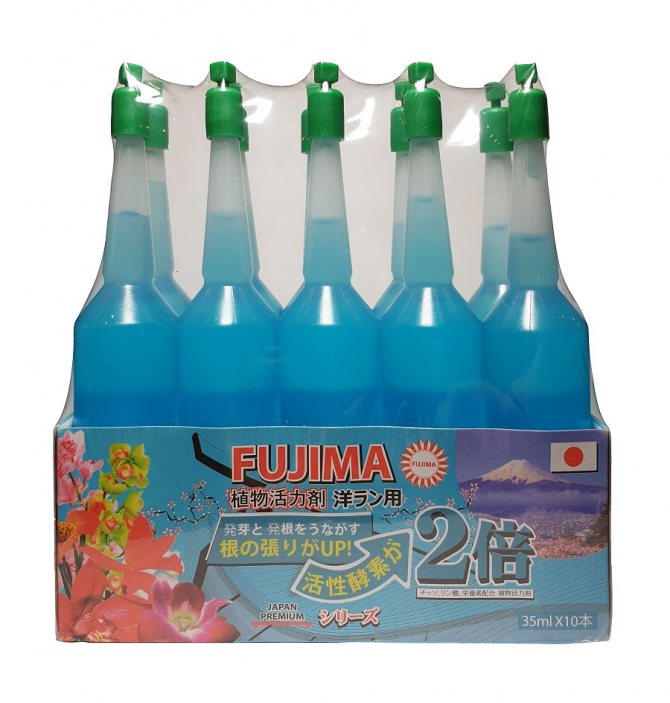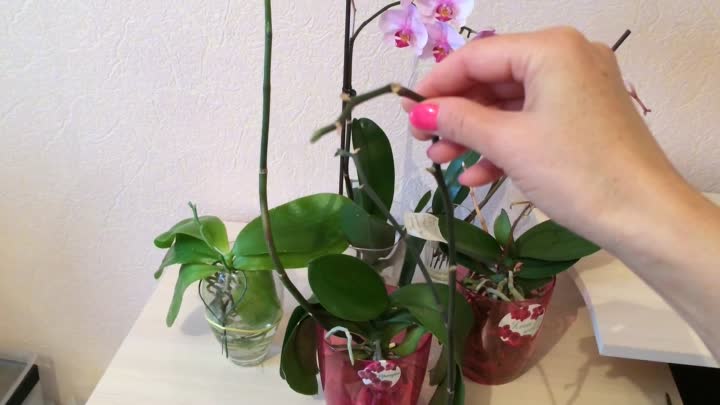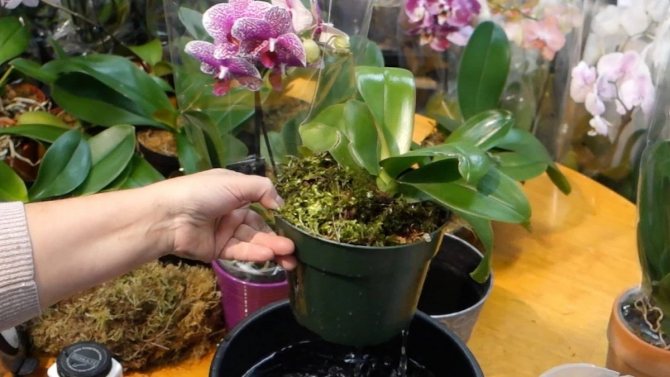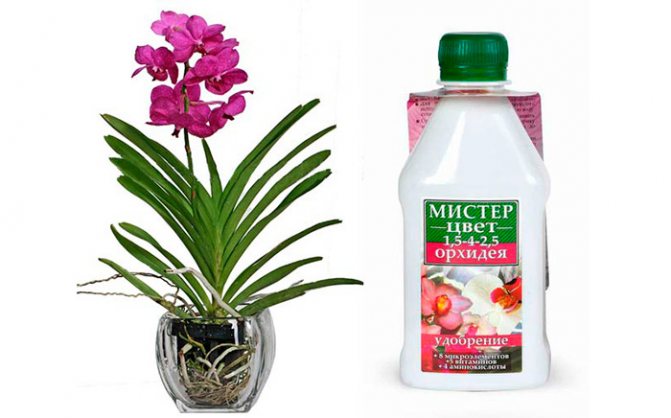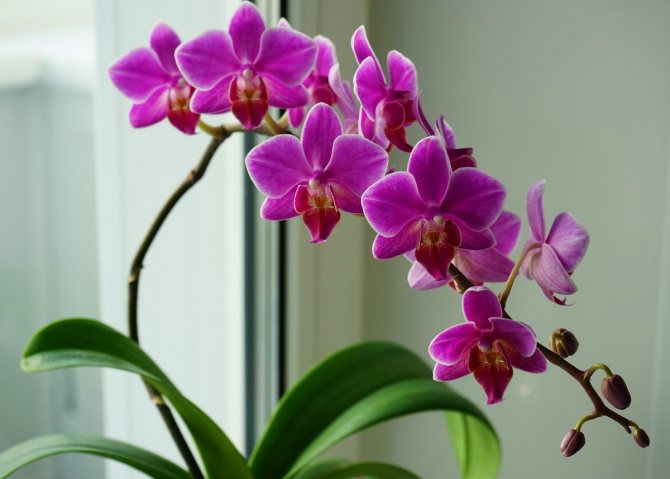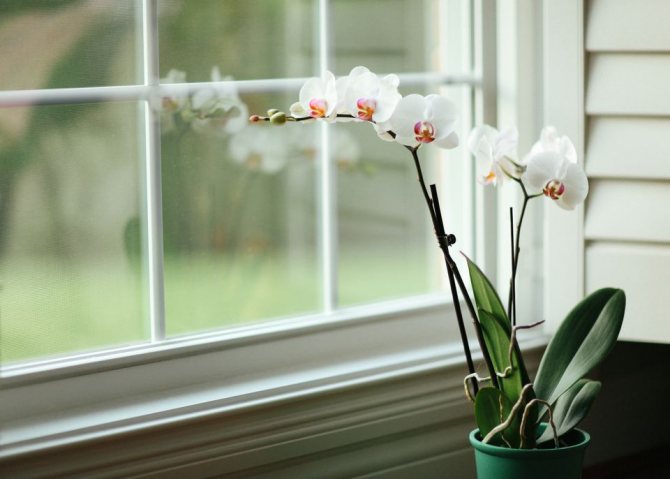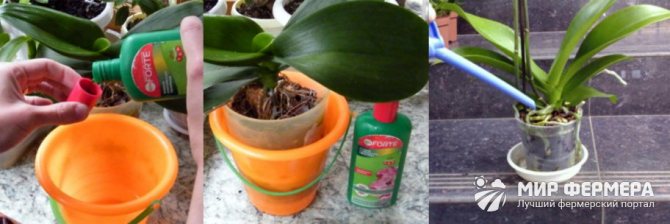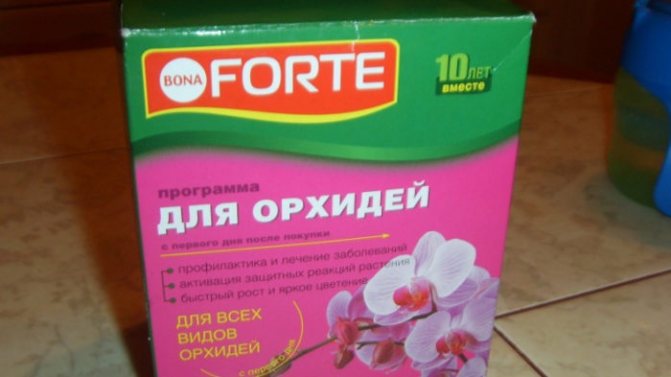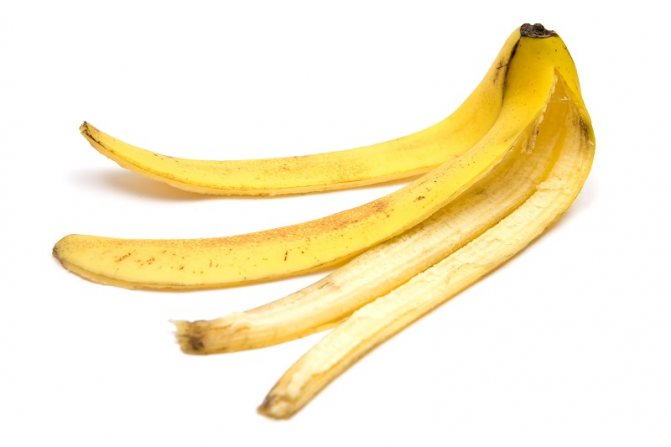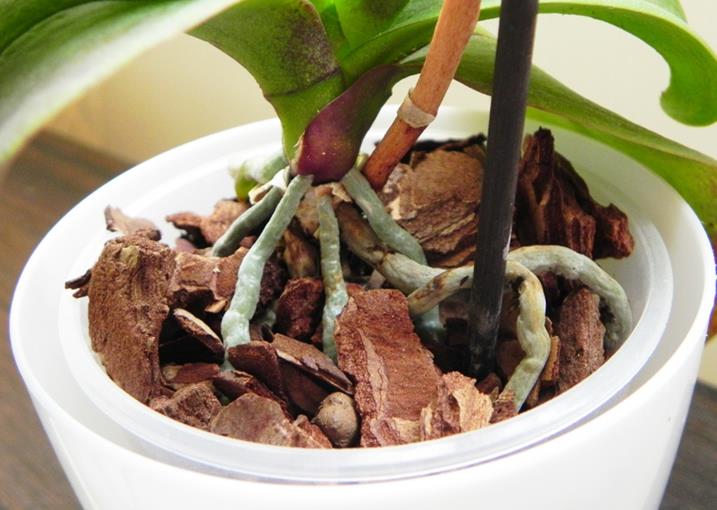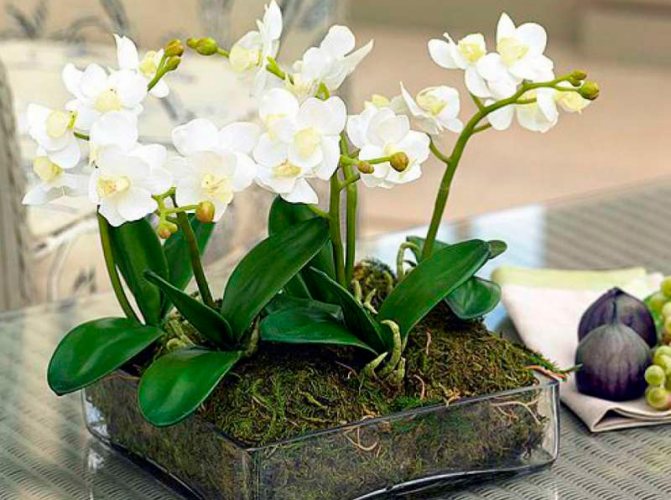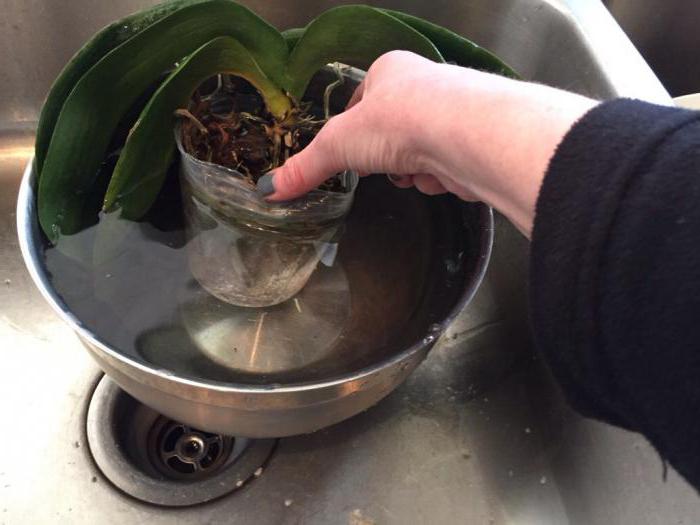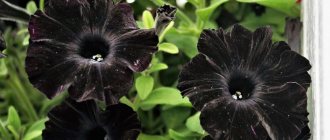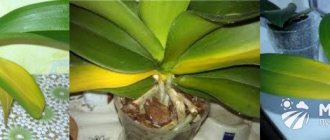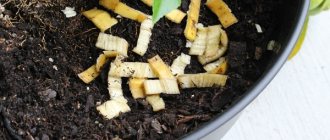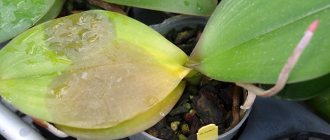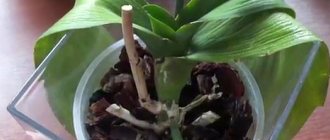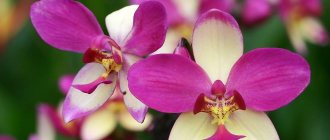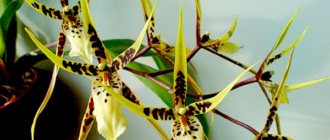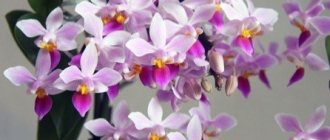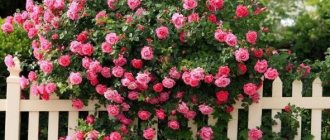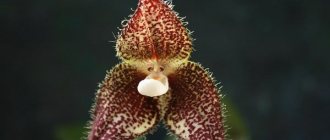Orchid is a plant of hot and humid tropical forests. Lives on tree trunks. It feeds on aerial roots. It receives moisture from the air and during tropical rainstorms, and also sucks it out of the tree on which it takes root. In addition to moisture, the plant needs fertilizing, especially during the period of flower-bearing, budding and flowering. In the wild, through its thick, rod-shaped roots, the flower can extract nutrients from its "patron" tree. But in an apartment where orchids are grown in an adapted substrate, consisting of the bark of coniferous trees and forest sphagnum, there is nowhere much for the plant to take moisture and food. That is why much attention is paid to the watering regime and top dressing when growing orchids in indoor floriculture. What do orchids “eat at home”? Fertilizers, of course. But, unlike other flowering pets, orchids need special feeding and a special schedule for getting them.
Can you fertilize?
The orchid can be fertilized, but only at the right time:
- In the spring, when the plant grows and gains strength for flowering.
- In summer, if the leaves continue to grow, but only until the first bud appears.
- With the onset of flowering, root dressings are replaced with foliar.
- In autumn, while the plant is still in bloom, you can only fertilize with leaves and aerial roots.
- In winter, the orchid needs rest, therefore, as soon as the plant has stopped growing, it is no longer worth fertilizing.
Essential minerals and elements necessary for an orchid
To find out how to fertilize an orchid, let's figure out which chemical elements are most useful for it:
- Nitrogen (N). Promotes an increase in the green mass of the plant by starting the processes of photosynthesis. Nitrogen deficiency manifests itself in the fragility of the stem, fading leaves, slowing down the development of greenery.
- Phosphorus (P). Helps root development and enhances the flowering process. Lack of phosphorus inhibits plant growth.
- Potassium (K). Promotes the development of flower buds, enhances plant immunity and carbohydrate metabolism. Potassium deficiency manifests itself in a small number of buds and a small size of flowers.
- Boron (B) and magnesium (Mg). Contributes to the normal absorption of nitrogen, potassium and phosphorus. The lack of these elements manifests itself in a slow growing season, drying of buds, and a shorter flowering time.
- Iron (Fe) and sulfur (S). The lack of these elements leads to disruption of the process of photosynthesis and the formation of chlorophyll (chlorosis). It manifests itself in yellowing and death of leaves.
Fresh articles about garden and vegetable garden
Pepper seedlings do not grow, stands still, what to do?
If the seedlings of cucumbers are very elongated, what to do?
Planting peas in spring sowing: when to sow, how to plant correctly?
Fertilizers for phalaenopsis orchids include other elements in their composition, but to a much lesser extent. The main triad ratio (NPK) is noted on the packages. If you need to build up green mass, then choose a 4: 3: 3 ratio. Use a 4: 6: 6 ratio to stimulate flowering. Experienced flower growers recommend having different types of dressings in stock. The most important rule is to adhere to the recommended doses, since an excess of fertilizer is extremely dangerous for orchids.
Do I need to do this?
Despite the fact that the orchid grows in a small volume of not very fertile soil, it still needs additional feeding.
On a note. Lack of nutrition will immediately respond to chlorosis. This is a disease in which photosynthesis in the leaves is disrupted, they turn yellow and fall off, and the plant itself begins to lag behind in development.
To prevent this from happening, it is necessary to apply the necessary fertilizers in a timely manner. In addition for lush flowering, the introduction of phosphorus and potassium is necessary. For the growth and development of shoots and leaves, nitrogen is needed.
There are some prohibitions:
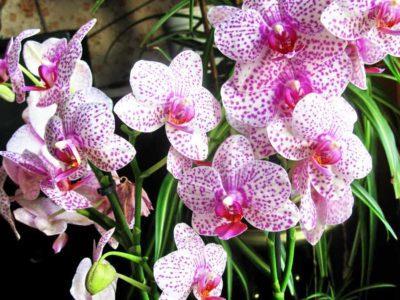
Do not apply root dressing to a weakened plant!- You cannot feed the orchid immediately after transplanting! Only when the plant adapts, after about a month.
- You cannot fertilize a newly purchased plant! Wait until the end of flowering, the orchid should get used to the new place.
- Do not apply fertilizer at the root during the period of active flowering! Only foliar feeding on leaves and outer roots.
- You can not fertilize plants during very hot weather and active scorching sun!
Orchid subrust so that it blooms
There are the following stimulants for the orchid to bloom. The Epin growth stimulator is very popular among flower growers. This drug is sprayed on the orchid every morning, adhering to a certain time.
Another solution that stimulates growth and antistress for orchids is succinic acid. 2 g of this acid is dissolved in 1-2 l of water. The solution is sprayed completely on the orchid. The solution with succinic acid must be consumed within 3 days.
It is strictly forbidden to treat the orchid with growth stimulants after transplantation; the flower needs some time to take root well. Remember to fertilize in moderation, according to the instructions.
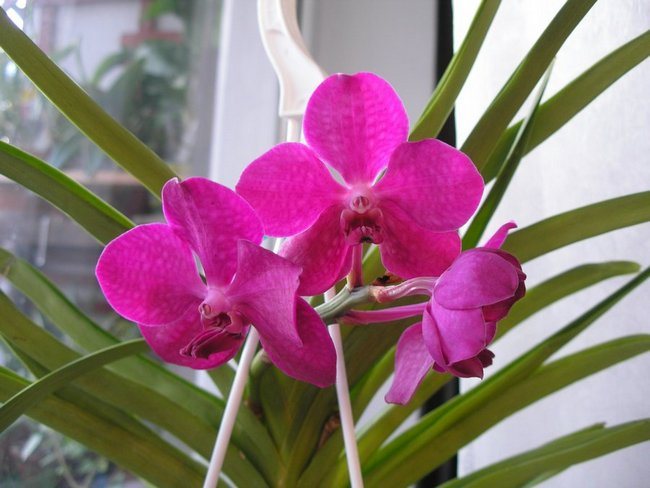

What are the consequences of feeding during the flowering period?
Let's figure it out right away: during the flowering period, only root feeding is prohibited. If you ignore this rule, the orchid can shed existing flowers and not form new buds. We continue to make foliar dressing. Otherwise, you can come to the opposite effect in the form of chlorosis of the leaves.
Why can't you feed during the flowering period? The fact is that the orchid has already accumulated everything necessary before the appearance of the peduncle. During the flowering period, it passes to the expenditure of the previously accumulated energy. By applying fertilizers at the root, we provoke a refusal from flowering in favor of the assimilation of fertilizers.
Fertilizers for orchids
The following fertilizers are most popular with orchid gardeners:
- BonaForte;
- Cameleon;


Fertilizer Cameleon - Kemira Lux.
Fertilizer for orchids Kemira Lux
Before each use of any top dressing, it is important to study the instructions. This is the only way to achieve the maximum effect. Otherwise, it is easy to harm the plant.
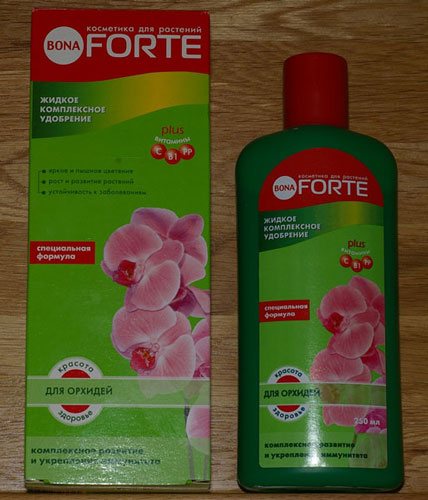

Fertilizer for orchids BonaForte
What to choose for a flowering plant?
As already mentioned, during the flowering period we use only foliar dressing. Now it's time to figure out which fertilizers should be used.
At home
Possible options
- Universal complex fertilizers for flowering plants only if you really need and there is nothing else. You need to take 3 times more water for dilution so that the solution is less concentrated.
- Liquid fertilizer for orchids Is a great option. It is only necessary to dilute fertilizer for feeding a blooming orchid with a double volume of water compared to the recommendations in the instructions. A good option is Bona Forte for orchids, the price of a 285 ml bottle is 140-180 rubles.
- There are special fertilizer solutions for foliar dressing of orchids. They come in spray form. It is very convenient to use.
Reference. Means "Orchid Myst" English production, 300 ml will cost from 550.There are also Russian counterparts, for example, Effect, 400 ml of which costs about 170 rubles.
What top dressing is not suitable
- Orchid soil tablets and sticks are not acceptable. In the ground for our beauty, they will be unevenly distributed. Areas of high concentration can damage the roots.
- Various folk methods can harm the plant. The orchid is a very delicate plant and requires careful concentration.
- It is better not to use universal complexes, only as a last resort.
On the street
In the open field, the orchid does not need fertilization so much., but those types of fertilizers are quite acceptable as for indoor specimens. For example, you can use Biona Flora fertilizer for orchids during the flowering period. The price of a 200 ml bottle is 110 rubles.
How to feed an orchid
Nutrition should be balanced. Composite homemade mixtures are not suitable for this flower, so it is best to purchase a fertilizer specifically designed for orchids and other epiphytes.
For successful color formation, a plant needs three elements:
- nitrogen;
- phosphorus;
- potassium.
All of them are necessarily contained in fertilizers for orchids, but in different proportions (the proportions must be indicated on the package as a percentage).
| Element | Act |
| Nitrogen | The flower needs it for the growth of leaves and their normal development. Without developed leaves, the feeding area is reduced, and the plant does not survive. |
| Phosphorus | Directly affects the formation of peduncles and blooming of flowers, as well as the duration of the flowering period |
| Potassium | Provides a full-fledged metabolism in plant tissues, is responsible for the intensity of photosynthesis, helps to develop immunity from diseases and pests. |
The percentage composition of these three elements in different fertilizers is different. Therefore, they need to be used differently in different seasons.
- When the flower grows leaves (spring), a fertilizer with an increased percentage of nitrogen is applied.
- When the plant is most susceptible to pests (summer), it is fertilized with a mixture with a high potassium content.
- During the formation of flower buds, budding and ejection of peduncles (in autumn), orchids need a lot of phosphorus.
Video - how to make an orchid bloom
detailed instructions
Let's take a look at the process of applying top dressing at home and on the street step by step.
In room
At home, feeding is done like this:
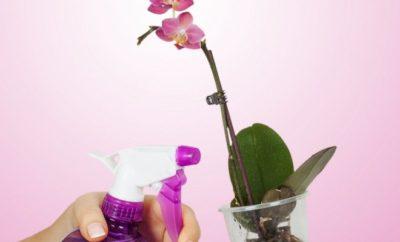

We fertilize 2 times a month, this is quite enough.- We dilute the required amount of fertilizers.
- For foliar feeding, the fertilizer concentration is half the usual one.
- Pour the solution into a spray bottle.
- The atomizer should be such that it gives not a stream, but a lot of small droplets.
- We shake the bottle before spraying, so as not to get a more concentrated fertilizer at the end, which can burn the plant.
- Spray the leaves evenly on both sides, lightly spray the aerial roots. Do not wet them too much.
- Do not spray flowers, the base of the shoots and the growing point.
- Feeding should be done in the morning or in the evening.
- You can not put the orchid after spraying in the sun.
Important! The leaves should dry out to avoid burns. - Foliar dressing can be done only in a warm room, the air temperature is from 18 to 26 degrees.
- The water for preparing the solution should be warmer than the air temperature by a couple of degrees.
- The water should be soft, settled.
In the open field
On the street we fertilize like this:
- We prepare a solution from warm water (about 20 degrees) and half the rate of fertilizer for orchids.
- Pour the prepared nutrient liquid into the spray bottle.
- Shake the solution one more time before applying.
- We spray only the leaf plates on both sides.
- Foliar dressing is carried out either in the morning, so that the leaves have time to dry before midday heat. Or we do it in the afternoon in cloudy weather.
- In the evening, it is highly undesirable to spray the orchid, otherwise at low night temperatures it will lead to diseases.
- Feeding can be done twice a month.
Features, principles of content
Unlike other indoor plants, the content of the orchid should be as close to natural conditions as possible. The root system is located close to the surface; instead of soil soil, a filler made of tree bark, expanded clay, mineral wool, artificial materials with the addition of sphagnum is used. The following factors are important for development and growth:
- moisture saturation mode;
- observance of air temperature;
- careful lighting of the plant and its roots (the orchid is bred only in transparent glass or plastic pots);
- top dressing.
Feeding rules
Healthy, strong, brightly flowering plants cannot be obtained without the use of nutrients and fertilizers, better, of natural origin. Orchid owners believe that abundant flowering can be achieved by adhering to some feeding rules:
- introduction of substances 2 weeks before the beginning of bud setting;
- compliance with the proportions, concentration, dosing of nutrient compositions, otherwise you can harm, burn the roots;
- due to the specifics of the soil, use fertilizers only in liquid form;
- a recently acquired flower cannot be fertilized, transplanted;
- weak, painful, transplanted orchids are not recommended to be fed;
- lack of fertilizers during the dormant period;
- nutrients are applied only to moist soil;
- the fertilizer composition used for the first time should be checked on one flower (in case of a negative reaction).
The need to make recharge can be understood by the appearance of the orchid. Signals are:
- pale, yellowish color of leaves;
- slowdown or lack of growth;
- lack of flowering;
- falling leaves and unopened buds.
Nutritious Recipes for Orchid Blossom
Florists use improvised home remedies to improve the abundance of flowering. There are a number of popular recipes that have a beneficial effect on growth, development, and budding. The main thing to remember is that all folk dressings are used in a weakly concentrated form, they have a shelf life of no more than a week.
Banana peel infusion
Like the banana itself, its peel contains a large amount of minerals and vitamins that are beneficial for the development of flower stalks. Making banana fertilizer is easy. Dried chopped peel of one banana is poured into 1 liter of warm water, insisted for 2-3 days. Then they filter, dilute with settled warm water in a ratio of 1: 2, gently water the plant.
Onion peel decoction
Fertilizers from onions contribute to the formation and growth of flower ovaries. To prepare a slightly saturated decoction of the husk, you will need 1 medium-sized onion, 1 glass of water. Pour the husk with water, boil for 10 minutes. over low heat, leave for 1-2 hours, drain. Before use, dilute the concentrate with water at room temperature to a light shade, water the flowers.
Potato recipe
Potato broth is a complete organic biostimulant for orchids. It is easy to prepare. Pour boiling water over the peelings from several medium-sized potatoes, leave for half an hour, filter. The resulting composition is heated to 35 degrees, the plants are watered. After regular application, root growth is observed, a large number of buds are formed on the flower arrow.
Tea and coffee fertilizer
An excellent way to feed home orchids is black tea and drunk coffee. Brewed tea is diluted with water to a light shade, watering is carried out no more than 1 time per month. Since, being a natural acidifier, tea is able to change the chemical composition of the soil.Drink coffee, brew again, leave for 10-15 minutes, dilute with water 1: 2, water the flowers.
Such infusions contain many minerals that affect the active growth of the flower, the restoration of leaf plates, and the duration of the flowering period. Folk methods are easy to prepare and available. Regular use of the recipes given will help orchids delight with bright floral abundance.
To each I want to see the florist the orchid is not only blooming, but also to see this beauty for as long as possible.
And each of those who keep this beautiful flower at home wondered: how to achieve abundant flowering of an orchid?
You will find the answers in this article.
Root feed
At the same time, we will consider the process of root feeding, which we need before flowering in spring. How to apply fertilizer at the root:
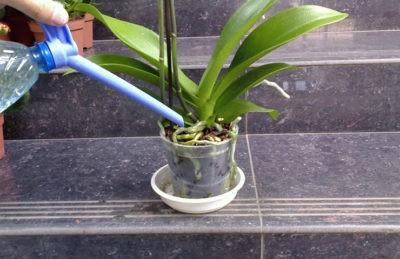

Before applying top dressing, you need to water the soil in the pot. Wet soil and roots saturated with moisture will ensure that there are no burns.- Dilute the liquid orchid fertilizer according to the instructions. Mix well.
- Pour the solution into a wide bowl so that the pot or pots fit freely.
- Put the orchids in this water for 20-25 minutes.
- Pour a small amount of the solution over the surface of the soil.
- Over time, the pot must be placed in a dry tray to drain excess moisture.
- We use only soft water to prepare the solution.
Reference. If the water is hard, it must be boiled first. - The water temperature should be slightly above room temperature.
- After the completion of the process, the orchid should not be immediately placed in direct sunlight.
What affects the flowering of an orchid at home?
As beautiful as the orchid flower, it is moody when grown at home.


In order for an orchid to bloom profusely, it needs good care.
But if you bring the climate closer to natural conditions, then you can observe flowering in several periods. To do this, you should perform and know a number of factors... Let's take a closer look: what to do to make the orchid bloom profusely?
Flower age
What to do to make orchids bloom luxuriantly and beautifully again? Before you wish that the orchid bloomed, you need to know a little about her age. If the flower is grown with your own hands, then the signal for flowering will be the age, which varies from 1.5 to 3 years. It is during this period that the plant reveals its potential.
The duration of the period is explained by the type of flower and the condition of the content. During this period of time, up to 5-8 adult leaves should form.
Flowering too early can lead to death... Since the plant will not have time to accumulate strength. When buying orchids in a store, you should pay attention to the presence of adult leaves.
Plant location, correct lighting
The southern part of the house - the most optimal location for an orchid. At the same time, the plant requires shading from direct rays.
When buds are formed, it is already undesirable to move the pots even a few centimeters. Not to mention their twist. All permutation procedures can be performed only with the formation of all the opened flowers.
This usually lasts 10 days. Then any corner of the house can be decorate with blossoming bunches flowers. The plant is not afraid of partial shade during this period.
When buying an orchid during the formation of peduncles, you should notice the side of the pot with which it is directed towards the light. Set houses in the same position. This will help him adapt in a short time.
Flowering time can come at any time of the year. The main thing here is to provide the plant with enough light. In winter, autumn time need artificial lighting.
Ambient temperature and humidity
Lack of light prevents the orchid from blooming. And the buds that appeared suddenly dry up and fall off... Some growers mistakenly think that the whole plant needs artificial light.
In fact, this is not the case. Enough to illuminate top only peduncle. Daylight hours should be 10-12 hours.
The ambient temperature in the room plays a significant role. Its best parameters during the day are from 20 to 24 degrees C, at night: 15-18. When the difference is within 5-6 degrees.
In the summer season, the orchid can take out to the balconywhere she will get a natural temperature difference. It is the drop that makes the plant bloom.


It is necessary to constantly monitor the temperature in the apartment.
Useful video
Top dressing of orchids. When to fertilize them:
To keep your orchid healthy and beautiful, you can use the following products: Zircon, Fitosporin, Epin, Aktara, succinic acid, vitamins, garlic water, cytokinin paste, Fitoverm.
What not to do when feeding an orchid
Orchids are usually sold in pine bark substrate in transparent plastic pots. In this case, the substrate acts rather as a support element than a source of nutrients. Therefore, in order for the flower to fully live, grow and bloom, it is necessary to follow certain recommendations for caring for the orchid, which include the choice of location, the degree of illumination, the frequency and abundance of watering and the criteria for feeding. There are the following restrictions regarding feeding:
A newly acquired flower should not be transplanted or fertilized. It makes no sense to transplant because the substrate is just a place for the plant to support, and not a source of nutrition, so the orchid can be left in the same substrate for another 3 years.
Feeding orchids during flowering is also not recommended, because, as already mentioned, the plant will shed not only all the flowers, but also the buds that are forming.
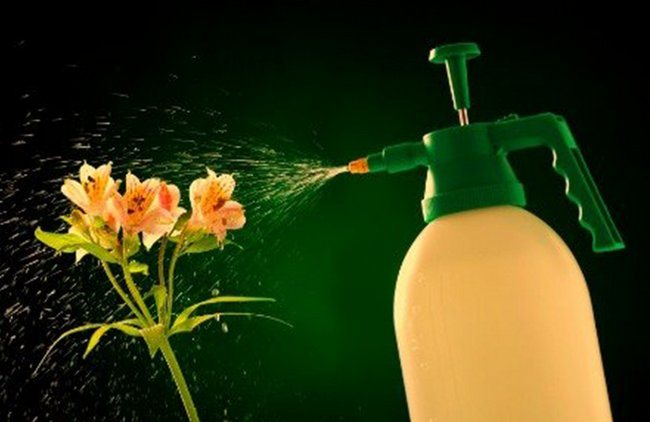

Questions From Readers About Blooming:
How to increase the duration?
Until the buds fully open keep the plant in a well-consecrated place, not less than 12 hours. Then rearrange the flower to another place with a lower temperature. Do not fertilize them during flowering.
When is stress good?
Not all stress is detrimental to flowers. Some of them stimulate flowering... For example, the difference between night and day temperatures by 4-5 degrees C, overdrying of the substrate. It is necessary to expose such stresses at a time when the plant has up to 8 leaves, that is, it is ready to bloom.
How does a sharp temperature drop affect?
There is a concept useful and tolerable temperature... When night readings vary within 15-18 degrees C, and daytime ones - 20-24, the transferred values are 15 and 24 degrees C, respectively.
The intermediate temperature is useful. Any deviation of the transferred values in one direction or another leads the plant to stress.
Consequences of mistakes and dealing with them
If the fertilizing is not carried out correctly, the plants may suffer.:
- get sick;
- get burned;
- drop flowers.
In such a situation, immediate action should be taken.
- Remove the orchid from the planter.
- Check the status of the root system.
- Treat them with fungicides as a prevention of decay.
- Transplant the plant into a pot that is 2-3 cm smaller in diameter.
Phalaenopsis are considered unpretentious orchids, but when they are kept, you cannot do without the introduction of fertilizing compositions. The optimal frequency is once every 2-3 weeks. Complex mineral fertilizers in a liquid state are considered the best. When introducing them, it is important to take into account the stage of plant development.
The importance of feeding
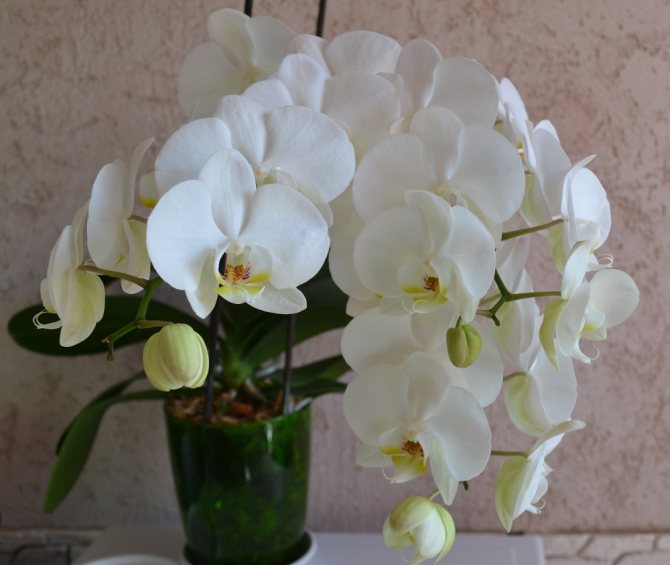

Most often, an orchid is acquired in a flowering state, but after a couple of weeks, flowering at first slows down, and then completely disappears. Peduncles die off one after another, leaving only brown long branches. The flower begins a resting phase - this is a state in which it rests, gains strength before the next flowering. However, it may not exist.The exotic beauty is so peculiar and capricious that it can stand on the windowsill for years, periodically releasing new leaves and roots, but never buds.
To bring an orchid out of the dormant phase, fertilizers are just needed. They quickly saturate the root system, from which it becomes active, and the plant begins to develop intensively over time. As a result, new peduncles and "babies" appear on the shoots. However, not all fertilizers are suitable for an orchid, moreover, they must be used correctly and in moderation.
Tips and tricks from experienced florists
First of all, it cannot be said that there is a super remedy for orchids. There is no substance that can simultaneously enhance immunity, protect against pests, and replenish all micro and macro elements.
Therefore, the only recommendation by experienced gardeners and orchid breeders is to track the stages of flower development and consistently apply the elements.
For beginners, it is not advisable to use folk methods or make fertilizer mixtures on their own. An experienced florist copes with such a task.
Testimonials
We offer a selection of reviews from the forums about fertilizer for orchids:
| Substral | To feed the flower "at the root" the agent is diluted as follows - 1 ml per two-liter container with water. |
| Etisso | To feed orchids, it should be diluted twice as weak as indicated in the description for the drug. |
| Greenworld | Before applying to the soil, this fertilizer is diluted two times weaker than it is written in the description of the preparation. This liquid solution can be used to feed “under the root»Before watering, avoiding droplets from falling on foliage and growth zones. |
| Compo | They can feed all types and varieties of these exotic plants. Designed for the development of vegetative mass and long flowering orchids. Volume - 0.5 l, country of origin - Germany. |
| Master | A very effective complex preparation containing a large amount of macro and microelements, amino acids and growth stimulants in a form that is easily assimilated by flowering houseplants. |
| Fasco | Fertilizer and soil "Flower happiness"- many growers say that after feeding with such a preparation, only roots and vegetative mass begin to actively grow in their orchids. But Fusco often gives impetus to the development of peduncles. |
| Pocon (Pokon) | Dilute 5 ml in 1 liter of water. The flower should be fed at the root. |
| Buyskoye fertilizer "Flower Paradise" | It contains all the necessary mineral compounds that are needed for the development of flowering indoor plants, and such a fertilizer is fast acting... Dose: 5 ml is diluted in 500 ml of water. |
| Joy (Joy) | Designed to feed only these tropical beauties. It actively promotes the development of vegetative mass and long, abundant flowering. Joy is well and quickly absorbed by the roots of orchids, it does not contain chlorine harmful to these flowers. |
What can you feed and what you can't?
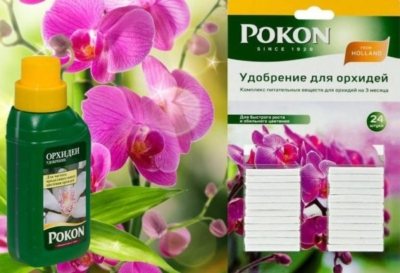

When growing orchids, various types of fertilizers are used: both chemical and improvised means from household waste, tested by popular experience. The best choice is considered to be the use of special tools that are produced by the industry in a wide range.
Not all experts recommend using stick fertilizers when growing phalaenopsis. They are unevenly distributed over the entire area of the pot and cannot provide the correct, timely supply of the necessary elements.
Why does the plant not bloom?
This plant began to appear more and more often on the windowsills of apartments and houses, but, unfortunately, an orchid may not always bloom as it does in nature... Sources of her good nutrition:
- Highly humidified air.
- The wood on which it grows.
- The soil.
As for home conditions, they differ significantly from natural conditions, so the orchid may not bloom without feeding. In addition, a special schedule is needed, which must be strictly followed.
Which remedy should you choose?
How to water the plant for flowering and so that it always blooms? One of the most advanced dressings today is Tsitovit. She is able to bring back a dried arrow to life. In addition, ovary shedding is prevented, there are no "dormant" buds, and is a prophylactic agent against many diseases. But an even greater effect is achieved when mixed with Zircon.
Step by step:
- Before feeding, the flower is watered abundantly.
- Both funds are mixed in equal proportions - 4 drops from each per liter of water. The water should be slightly warmer than room temperature.
- The flowerpot with a flower is slowly lowered into a container with fertilizer for 15 minutes, while the bark must be held with your hands in order to avoid its displacement. In addition, it is necessary to add the solution through the top of the flowerpot.
- Having taken out the pot, you need to wait for the excess solution to drain back into the container.
Reference! After watering, the flower should not remain in a cold room.
The basic rule for feeding is measure. Better to apply less fertilizer and not overfeed than vice versa. Universal fertilizers should be diluted three or even four times.
In order for the orchid to grow healthy and bloom well, we recommend that you familiarize yourself with other feeding means: succinic acid, garlic water, Agricola, vitamins.
DIY organic solutions
The best fertilizers for orchids at home:
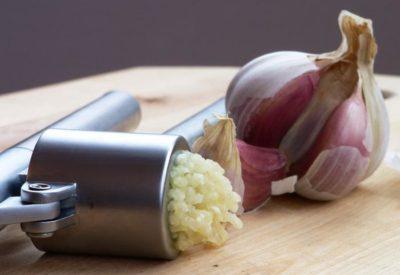

Garlic water... Garlic is very rich in vitamins, macro- and microelements, organic acids, sulfur, zinc, antioxidants, which are well absorbed and are an effective fertilizing and natural insecticide and fungicide.
The solution is easy to prepare:- 1 liter of water (34-36 degrees) will require a gruel of 1 clove of garlic squeezed through a press;
leave the solution for 40 minutes, strain and apply as a root and foliar treatment.
- Horse dung dissolve in water and pour over the roots. You can also use dry manure for transplanting, spreading it between parts of the substrate and over the surface in small quantities.
- Dried Banana Peels need to be cut and soaked in warm water for several days. Then, with a strained solution, carry out root dressing. Useful to stimulate flowering.
Basic prerequisites for abundant flowering
Orchid bloom lasts 3 months, and some specimens, depending on the species, can please up to 8 months. For the abundant flowering of the orchid influenced by the following factors:
- As soon as all the buds open, the flower is rearranged in partial shade. In this case, the sun's rays will be unnecessary;
- Adhere to a cool temperature from 17 degrees C to 22;
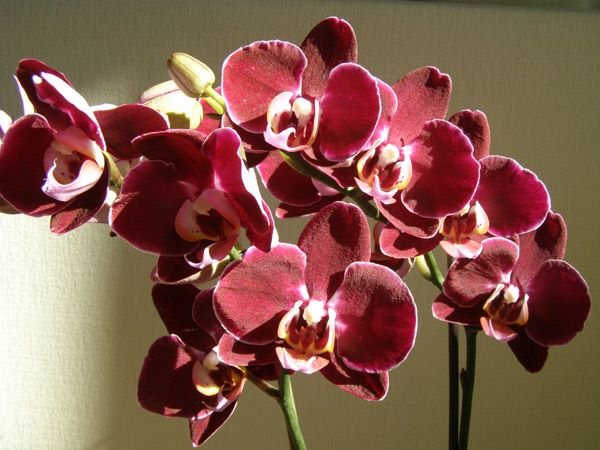

Several factors affect the abundant flowering of an orchid.

